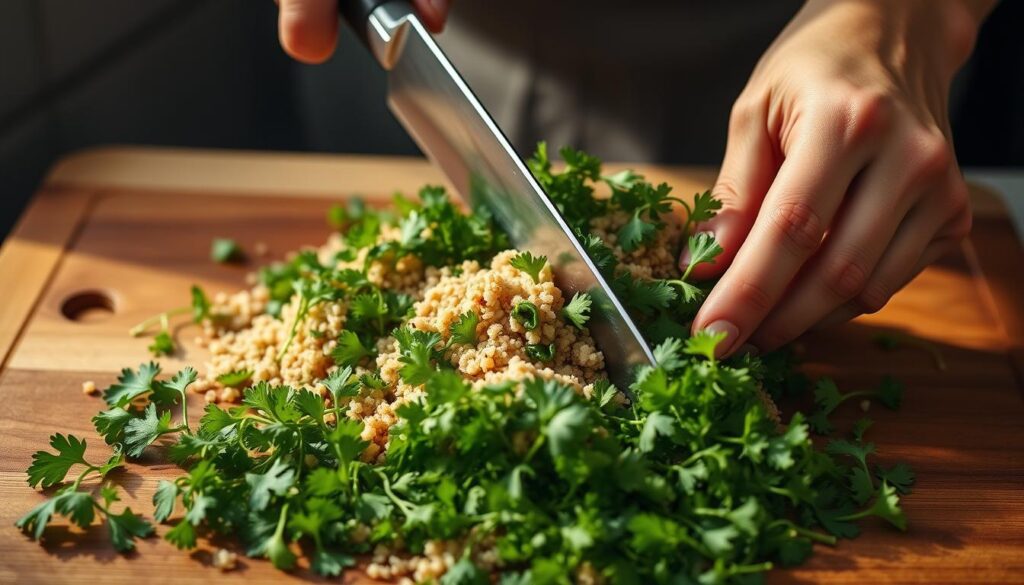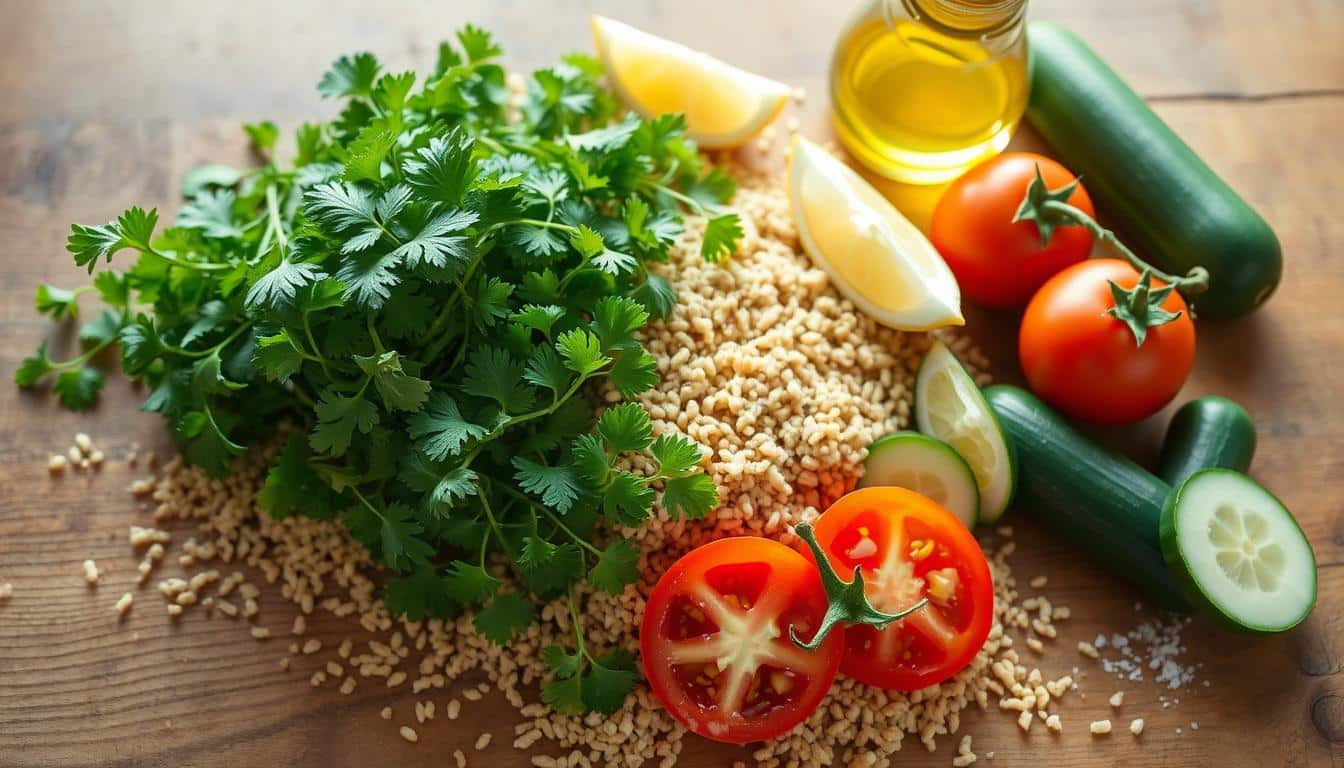Have you ever bitten into a dish that feels like a symphony of flavors and textures? For me, that dish is tabbouleh. This vibrant Mediterranean salad is more than just a meal—it’s an experience. Made with finely chopped parsley, extra fine bulgur, and a zesty blend of olive oil and lemon, tabbouleh is a celebration of freshness and simplicity.
Thank you for reading this post, don't forget to subscribe!What makes this recipe stand out is its balance of flavors. The earthiness of bulgur pairs perfectly with the brightness of lemon, while parsley adds a fresh, herbaceous note. It’s a salad that’s light yet satisfying, making it perfect for any time of the year. And the best part? It’s incredibly easy to prepare, requiring just a few quality ingredients and some chopping.
Traditionally, tabbouleh is all about the herbs. In fact, genuine tabbouleh should focus more on parsley than bulgur, which is something I’ve learned from my own kitchen experiments. This approach ensures that every bite is bursting with freshness, rather than being weighed down by too much grain. It’s a small detail that makes a big difference in the overall taste.
Ready to dive into the world of tabbouleh? Let’s explore how to make this Mediterranean classic with a few simple steps. I promise you, the result will be nothing short of delightful!

Key Takeaways
- Tabouleh is a Mediterranean salad primarily made with parsley, bulgur, and a zesty dressing.
- The recipe emphasizes using extra fine bulgur and finely chopped ingredients for optimal texture.
- It’s traditionally herb-focused, with parsley playing the starring role.
- The salad is easy to prepare and requires minimal cooking.
- Allowing the salad to chill before serving enhances its flavors.
Introduction and Background
Have you ever wondered where your favorite dishes come from? Tabbouleh, a vibrant Middle Eastern salad, has a rich history that spans centuries. Originating in the Middle East, this dish has become a staple in Mediterranean cuisine, cherished for its fresh flavors and simple preparation.
Traditionally, tabbouleh is crafted with extra fine bulgur wheat, which is soaked in water to achieve the perfect texture. The salad emphasizes fresh ingredients, particularly parsley, which gives it a bright, herbaceous flavor. A zesty dressing made from lemon juice and olive oil brings all the components together, creating a harmonious balance of tastes.
Over time, tabbouleh has journeyed from its Middle Eastern roots to become a global favorite. Today, it’s widely available in supermarkets worldwide, a testament to its universal appeal. I still remember my first encounter with tabbouleh at a local Middle Eastern restaurant—it was love at first bite! The combination of textures and flavors was unlike anything I’d ever tasted.
| Component | Description |
|---|---|
| Bulgur Wheat | Extra fine, soaked in water for texture |
| Parsley | Fresh and finely chopped for vibrant flavor |
| Lemon Juice | Provides a zesty, refreshing dressing |
| Tomatoes | Diced fresh for added crunch and flavor |
This traditional salad has evolved, yet its essence remains unchanged. It’s a delightful blend of heritage and modernity, making it a beloved choice for many. Whether you’re exploring global cuisines or seeking a healthy meal option, tabbouleh offers a flavorful experience that never disappoints.
Ingredients Spotlight: Tabouleh: A salad made with parsley, mint, tomatoes, and bulgur
Let’s dive into the heart of this recipe—the ingredients that make it truly special. Each component plays a vital role, ensuring every bite is a perfect blend of flavor and texture.
Herbs and Fresh Produce
The star of the show is parsley, which brings a vibrant freshness. I love how it adds a bright, herbaceous flavor that makes the dish feel alive. Mint is another key player, offering a cool contrast to the earthiness of the bulgur. Together, these herbs create a balanced and refreshing taste experience.
When it comes to vegetables, ripe tomatoes add natural sweetness and a satisfying crunch. Fresh cucumber brings a light, refreshing touch, while keeping the dish crisp and delightful. These ingredients work together to create a salad that’s as healthy as it is flavorful.
Choosing the Right Bulgur
Bulgur is the backbone of this salad. I always opt for extra fine bulgur because it soaks up just the right amount of water, giving it a tender yet firm texture. Coarser varieties can make the dish feel heavy, so fine bulgur is the way to go for that perfect bite.
| Ingredient | Description |
|---|---|
| Parsley | Finely chopped for vibrant flavor |
| Mint | Optional, adds cool contrast |
| Tomatoes | Diced for natural sweetness |
| Bulgur | Extra fine for ideal texture |

Using fresh, high-quality ingredients is key to bringing out the best in this salad. Measuring cups ensure precision, and finely chopping each component guarantees a delightful texture. This careful preparation makes every bite a joy to eat.
How to Prepare the Perfect Tabouleh
Creating the perfect tabouleh is all about balance and timing. Let’s break it down into simple steps that I’ve perfected over time.
Prepping Vegetables and Herbs
Start by washing all your vegetables and herbs thoroughly. Finely chop the parsley, mint, and scallions by hand for the best texture. Dice the tomatoes and cucumbers, then drain them well to avoid a watery consistency.
Draining is crucial—it ensures every bite stays crisp and fresh. I like to let them sit for about 10 minutes to remove excess moisture.
Creating a Vibrant Dressing
In a small bowl, whisk together ⅓ cup of olive oil and 3 tablespoons of fresh lemon juice. Add a pinch of salt and a dash of black pepper to taste. This dressing is the heart of the dish, bringing everything together.
- Pour the dressing over the bulgur and let it sit for 30 minutes.
- Gently mix in the chopped herbs and vegetables.
- Allow the salad to chill for another 20 minutes to meld the flavors.
Every minute counts here—too little time and the flavors won’t meld; too much and the texture suffers. I’ve found that 30 minutes is the sweet spot for the bulgur to absorb just the right amount of dressing.
Essential Tools and Techniques for Fine Chopping
Fine chopping is the backbone of a great tabbouleh. The right tools and techniques can make all the difference, ensuring your ingredients are evenly cut without losing their vibrant flavors and textures.
Knife Versus Food Processor
When it comes to chopping, you have two main options: a sharp knife or a food processor. A sharp knife offers precision, allowing you to control the size of each piece, which is especially important for delicate herbs like parsley. This method prevents the herbs from wilting and keeps their fresh flavor intact. On the other hand, a food processor is faster and ideal for larger quantities, but it requires careful use to avoid over-processing, which can turn your herbs into a mushy texture.
| Tool | Pros | Cons |
|---|---|---|
| Knife | Precision control, prevents wilting, maintains texture | Time-consuming, labor-intensive |
| Food Processor | Quick, efficient for large batches | Risk of over-processing, less control |
Chopping Tips from My Kitchen
From my experience, the key to perfect chopping is balance. Use a sharp knife to finely chop your herbs and vegetables, ensuring even sizes for consistent flavor. When using a food processor, pulse briefly to avoid over-chopping. For the best texture, leave some ingredients slightly coarse while others are finely chopped. This mix adds depth to your dish. Remember, precise instructions are crucial—over-processing can ruin the texture, so keep an eye on your work.

For more detailed guidance, visit this recipe to master the art of chopping for your tabbouleh.
Flavor Enhancements: Olive Oil, Lemon Juice, and More
The dressing is the heart and soul of this dish, transforming it into a flavorful masterpiece. To elevate the basic dressing, it’s all about balancing acidity and richness.
Dressing Secrets
Start with high-quality olive oil. Early Harvest extra virgin olive oil is a great choice—it’s rich and fruity, adding depth without overpowering the other ingredients. When selecting oil, look for something that’s vibrant and full of life; this will make a big difference in the overall flavor.
Next, let’s talk about lemon juice. Freshly squeezed juice is essential. I always squeeze my lemons just before mixing the dressing to ensure maximum freshness. The acidity of the lemon juice cuts through the richness of the oil, creating a perfect harmony of flavors. To balance it out, I use a simple ratio: 3 parts oil to 1 part lemon juice. This ensures the dressing isn’t too tangy or too heavy.
Pepper plays a crucial role here. A pinch of freshly ground black pepper enhances the flavors without overwhelming them. It adds a subtle kick that ties everything together. Fat, in the form of oil, brings it all together, coating the ingredients evenly and ensuring every bite is flavorful.
Optional Additions for a Modern Twist
If you’re feeling adventurous, there are plenty of ways to give the dish a modern twist. A sprinkle of red pepper flakes can add a spicy kick, while a drizzle of extra virgin olive oil can enhance the richness. For something fruity, try adding a handful of pomegranate seeds—they add a burst of freshness and color to the dish.
These small additions can transform the dish into something new and exciting. Whether you stick to tradition or try something modern, the key is to let the flavors shine. The result is a dish that’s not only delicious but also visually appealing.
For more inspiration, check out this recipe that showcases how olive oil and lemon juice can elevate flavors in a completely different dish.
Serving Suggestions and Pairings
Tabbouleh is incredibly versatile, serving as both a refreshing side dish and a light, satisfying meal. Its fresh flavors make it a perfect addition to any gathering or everyday dining.
Perfect Accompaniments
For a truly authentic experience, serve tabbouleh alongside classic Middle Eastern dishes. Pita bread is a traditional choice, allowing you to scoop up every flavorful bite. It also pairs wonderfully with hummus, falafel, and grilled kabobs for a well-rounded meal.
Adding a protein like grilled chicken or roasted tofu can transform this dish into a more filling option. This makes it ideal for those seeking a hearty yet healthy meal.
Presentation Ideas
Presentation can elevate your tabbouleh game. Consider serving individual portions in small bowls or cups for a charming touch. For a creative twist, fill large lettuce leaves with the salad, creating crisp, edible boats that add both color and freshness to the table.
I love serving tabbouleh at family gatherings. It’s always a hit, and the vibrant colors make it a centerpiece. Each serving becomes a memorable moment, turning any ordinary day into something special.
| Serving Style | Accompaniment | Why It Works |
|---|---|---|
| Individual Bowls | Pita Bread | Convenient and portion-controlled |
| Lettuce Boats | Grilled Chicken | Visually appealing and fresh |
| Family Platter | Hummus and Falafel | Encourages sharing and variety |
For more inspiration on enhancing your meals, check out this recipe that showcases how olive oil and lemon juice can elevate flavors in a completely different dish.
Tips for Storing and Enjoying Fresh Tabbouleh
Keeping your tabbouleh fresh for days is easier than you think! Proper storage can maintain its vibrant flavors and crisp texture, ensuring every bite stays delightful.
Storage Methods
To keep your tabbouleh fresh, store it in an airtight container in the refrigerator. This simple step can keep it fresh for up to 3-4 days. However, some ingredients like herbs may lose a bit of their zing over time.
- Drain Excess Water: Before storing, drain any excess water from the vegetables to prevent sogginess.
- Use Quality Containers: Invest in a good airtight container to lock in freshness and flavors.
- Let It Rest: Avoid stirring or disturbing the salad once stored. Let it rest to allow flavors to meld.
- Soak, Don’t Cook: Soaking bulgur instead of cooking it helps maintain flavor over several days.
For a fresh touch, add a sprinkle of fresh mint just before serving. This simple trick revives the salad’s vibrancy and flavor.
With these tips, your tabbouleh will stay fresh and flavorful, ready to enjoy whenever you crave it!
Conclusion
As we conclude our journey through the world of tabbouleh, it’s clear why this dish holds a special place in so many hearts. A genuine tabbouleh recipe thrives on simplicity and quality ingredients, creating a harmonious balance of flavors and textures that resonate deeply with Mediterranean traditions.
Each ingredient plays a vital role, from the brightness of fresh lemon to the crunch of finely chopped vegetables. Even in just a few minutes of preparation, careful attention can unlock deep flavors and a delightful texture. I take great joy in sharing this tabbouleh recipe, which honors tradition while inviting innovation.
I invite you to give this salad a try and share your own experiences. Whether you stick to tradition or add your twist, the key is to let the flavors shine. Happy cooking, and I hope every bite brings you as much joy as it has brought me!
FAQ
What is the origin of Tabbouleh?
Tabbouleh is a classic Middle Eastern dish that originated in Lebanon. It’s traditionally made with fresh herbs, bulgur wheat, and a zesty dressing, making it a refreshing and flavorful salad.
How do I choose the best bulgur wheat for Tabbouleh?
Opt for fine or medium-grade bulgur wheat, as it absorbs the dressing nicely and ensures the right texture. Avoid coarse bulgur, as it can make the dish too chewy.
Can I use a food processor to chop the herbs and vegetables?
Yes, but be careful not to overprocess. Use short pulses in your food processor to keep the herbs and veggies finely chopped but still crisp and fresh.
How long does it take to prepare Tabbouleh?
Prep time is about 20-25 minutes, most of which is spent chopping. The dish comes together quickly once all ingredients are ready, making it a great option for a fast, healthy meal.
What’s the best way to store Tabbouleh?
Store it in an airtight container in the fridge for up to 2 days. Let it sit at room temperature for 10-15 minutes before serving to allow the flavors to refresh.
Can I customize Tabbouleh with other ingredients?
Absolutely! Feel free to add grilled chicken, feta cheese, or roasted vegetables to give it a modern twist. It’s a versatile dish that can easily be adapted to your taste preferences.
Why is lemon juice important in Tabbouleh?
Lemon juice adds brightness and balances the earthiness of the bulgur and herbs. It’s essential for creating that signature tangy flavor that defines the dish.
Is Tabbouleh healthy?
Yes, it’s a nutrient-packed dish! The fresh herbs provide vitamins and antioxidants, while the bulgur offers whole grains and fiber, making it a healthy and satisfying choice.
Can I make Tabbouleh without olive oil?
While olive oil is traditional, you can substitute it with another neutral oil like avocado or grapeseed. However, olive oil adds a unique flavor that enhances the dish.
How do I prevent the bulgur from becoming mushy?
Rinse the bulgur under cold water, then soak it just until it softens slightly. Drain thoroughly and let it sit to absorb excess moisture before mixing with other ingredients.
There are no reviews yet. Be the first one to write one.

